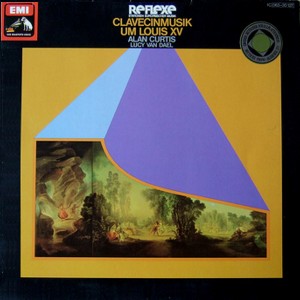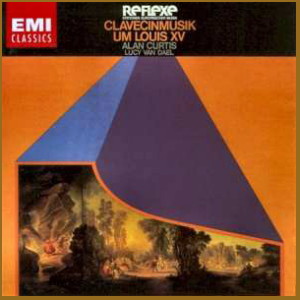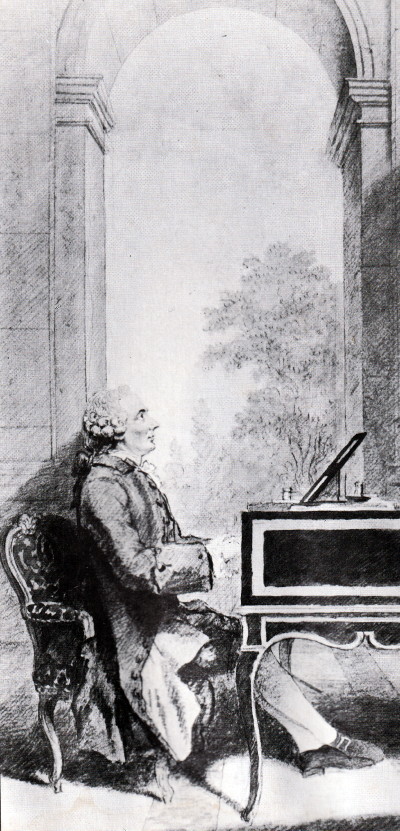 |
1 LP -
1C 063-30 127 - (p) 1976
|

|
| 1 CD - 8
26495 2 - (c) 2000 |
|
| CLAVECINMUSIK UM LOUIS XV -
Französische Cembalomusik des späten
Rokoko |
|
|
|
|
|
Claude-Benigne
Balbastre (1729-1799)
|
|
|
| Aus "Pièces de
clavecin, Premier Livre (1759)" |
|
|
| - La De Caze
- (Ouverture, fièrement et
marqué) |
3' 58" |
|
| - La
d'Héricourt - (Noblement,
sans lenteur) |
3' 44" |
|
| - La Courteille
- (Air) |
2' 43" |
|
| -
La Lugeac - (Giga, Allegro) |
2' 28" |
|
| Armand-Louis
Couperin (1725-1789) |
|
|
| Aus "Sonates en
pièces de clavecin avec
accompagnement de Violin ad
libitum, œuvre II (1765)" |
|
|
| -
Allegro |
2' 26" |
|
| - Andante |
4' 43" |
|
| - Minuetto |
2' 31" |
|
|
|
|
| Armand-Louis
Couperin (1725-1789) |
|
|
Aus
"Pièces de clavecin, Premier Livre
(1752)"
|
|
|
| Suite en
si-bémol (majeur / mineur) |
|
|
| - La du Breuil |
2' 30" |
|
| - La Chéron |
3' 59" |
|
| - L'Affligée |
3' 28" |
|
| - L'Enjouée |
2' 38" |
|
| Suite en sol
(majeur / mineur) |
|
|
| - L'intrèpide |
2' 31" |
|
| -
La de Boisgelou |
4' 28" |
|
| -
Menuets |
2' 46" |
|
| -
L'Arlequine ou la Adam |
2' 41" |
|
|
|
|
| Alan
Curtis, Cembalo (von
Martin Skowroneck, 1973 nach einem
französischen Modell mitte des 18.
Jahrhunderts) |
|
| Lucy
van Dael, Violine
alter Mensur (von Gennaro
Gagliano, 1732) |
|
|
|
|
|
Luogo
e data di registrazione |
|
Monnonitenkirche,
Haarlem (Olanda) - 15-16 settembre
1975 |
|
|
Registrazione: live /
studio |
|
studio |
|
|
Producer / Engineer |
|
Gerd
Berg / Johann-Nikolaus Matthes |
|
|
Prima Edizione LP |
|
EMI
Electrola "Reflexe" - 1C 063-30
127 - (1 lp) - durata 48' 29" -
(p) 1976 - Analogico |
|
|
Prima Edizione CD |
|
EMI
"Classics" - 8 26495 2 - (1 cd) -
durata 48' 29" - (c) 2000 - ADD |
|
|
Note |
|
- |
|
|
|
|
|
 LE
CLAVECIN SOUS LOUIS XV LE
CLAVECIN SOUS LOUIS XV
French
harpsichord music of th late
Rococo.
French
harpsichord music is commonly
assumed to have enjoyed its
finest flowering during the grand
siècle
of Louis XIV. Yet the best
compositions for clavecin
by both François
Couperin and Rameau
appeared only after the death
of the Sun King in 1715. Moreover,
itwas during the reign
(1723-1774) of his
great-grandson, Louis
XV, that the clavecin
finally reached the height of
its popularity, a zenith
marked both by the production
of vast numbers of superb
five-octave, double-manual
harpsichords and by the
composition of much brilliant,
tender and supremely idiomatic
music to be played on them.
But this flowering faded fast
in the course of the 1750s,
and Rameau
himself lived to witness a
glorious but melancholy “crépuscule
du clavecin”.
The 1750s was a period of
great change in French art. Much of
what is commonly associated
with the later style Louis
XVI, such as Soufflot’s
Pantheon, for example, was
actually conceived during this
decade. Not
only did the Guerre des
Bouffons bring fresh
triumphs of Italian over
French style, but there was
another, perhaps more
devastating musical invasion
from the East. Stamitz came to
Paris, and the style
associated with the Mannheim
Court became the vogue. In
harpsichord music it was
especially Schobert who,
according to his
propagandizing countryman
Baron Grimm, “completely
destroyed the reputation of
(Armand-Louis) Couperin, of
Duphly, of Balbastre”.
Rameau,
however,
had a different viewpoint.
He remarked to Balbastre, that
“Music is going to wrack
and ruin; people are changing
style at every instant".
Clearly he looked
upon his friend and fellow Dijonnais
as an upholder of the French
tradition forthe future - as
well he might, when he heard
such a piece as La
d’Héricourt. When
Balbastre first heard Taskin
play an English piano at the
Tuileries, he exhorted that
“this newcomer shall never
dethrone the majestic
harpsichord”. But alas, not
long afterwards Balbastre too
succumbed, ate his words, and
modernized his style, adapting
it to the pianoforte. Mercifully,
Rameau
was by this time dead. And
fortunately for
harpsichordists today,
Balbastre, Armand-Louis
Couperin, and Duphly had
meantime published their Pièces
de clavecin - music of a
strongly French character even
when not traditional, and
among the very last works ever
to be truly idiomatically
conceived for the instrument.
The present recording gives a
sampling of the best music by
two of the three great clavecinistes
of the era (the third, Duphly,
will be represented on a
future release). While
Duphly seems to have made his
living entirely as a
harpsichord teacher and to
have died in obscure poverty,
Balbastre and Armand-Louis
Couperin remained famous as
organists (the former also as
a pianist) even after the
harpsichord declined in public
favor. The latter two seem
also to have been friends
rather than rivals, and
Balbastre introduced
Dr. Charles Burney to Couperin
on June 18, 1770. The great
English music historian
"...was glad to see
two
eminent men of the same
profession so candid and
friendly together".
The two pursued similar
careers as organists and
harpsichord teachers, yet their
music is as different as their
characters must have been. Balbastre, 15th
of the 17 children of a Dijon
organist, was
a rather flampoyant society
idol, with high-born pupils as
diverse as Marie-Antoinette
and Thomas Jefferson’s
daughter. Couperin, only son
of Nicolas and grandson of
François
the elder (the brother of
Louis and uncle of the famous
François)
was a
native Parisian and apparently
a quiet, family man.
Balbastre
honored Madame De Caze with
the dedication of his first
book as well as the title of
the first piece it contains.
Anne-Nicolas-Robert De Caze
de Juvincourt, know as "le
beau danseur" (1718 - 1762)
inherited enormous wealth,
but ended in bankruptcy.
Also called "le fou tulipier", he
once paid 30.000 livres
for a single bulb. He
recovered some of his
losses through his
second marriage in 1747
to Susanne-Félix
Lescarmotier, heiress as
well as harpsichordist,
whose reputation for
promiscuity was later
equalled by that
of her sons. Duphly
named a
piece for her in
his Second
Livre
(1748), as he did
also for the abbé
d’Héricourt.
Probably both were
studying with
Duphly at that
time, but switched
to Balbastre after
his arrival in
Paris Oct. 16
1750. Little is
known about
Jacques-Dominique
de Barberie,
marquis de
Courteil (or
Courteilles) (1697
to 1768), a
forgotten
statesman,
financier,
acquaintance of
Casanova, and
sometime
ambassador to Switzerland.
On the other hand,
Charles-Antoine de
Guerin, a page of
Louis XV and
self-styled
Marquis de Lugeac,
while
a mere upstart in
his day, was
immortalized
through
is connexion
with Algarotti in
a scandalous poem
by Voltaire, sent
to Frederick the
Great in 1740:
Grand roi, ie vous
l’avais predit
Que Berlin
deviendrait Athène
Pour les plaisirs
et pour l’esprit;
La prophétie
etait certaine.
Mais
quand, chez le
gros Valori,
Je vois le tendre
Algarotti
Presser d’une vive
embrassade
Le beau Lugeac,
son ieune ami,
Je crois voir
Socrate affermi
Sur la croupe
d’Alcibiade...
The dedications of
Couperin’s pièces
reveal quite a
different
character and
ambiance than
Balbastre’s.
Instead of
complimenting the
wealthiest patrons
of society,
Couperin pays
homage to a
humbler folk: his
fellow musicians.
Jean Dubreuil (ca.
1710-1775)
published a Manuel
harmonique
in 1767 and a
collection of
songs in 1769.
André
Cheron
(1695-1766),
Campra's
godson and a pupil
of Bernier, was
in turn the
teacher of Leclair
and is said to
have written
the basses for
that composer’s
earliest published
violin sonatas. He
vvas
harpsichordist at
the Opera from
1734 and principal
conductor from
1750.
The striking
contrast between
the incredibly
dissonant,
profoundly
mournful L’Affligée
and the
irrepressibly
bumptuous
good-nature of L’Enjouée
suggests a pair of
portraits, again
of friends rather
than patrons. François-Paul
Roualle de
Boisgelou
(1697-1764) was
a musical
theorist, but the
piece bearing his
name is perhaps
rather a tribute
to his son,
Paul-Louis, a
child prodigy on
the violin, and a
composer. L’Arlequine
evokes the commedia
dell’arte
associations of
the composer Jean
Adam, whose
ballets and
symphonies,
arranged for
harpsichord,
survive in several
18th-century
collections. It
was
this Adam who
revised and re-wrote
Rameau's
Zoroastre
for Dresden in an
Italian
translation by
Casanova,
described in the
famous Mémoires.
In
Couperin’s second
publication, more
than a decade
later, we
meet with
a typical
phenomenon of the
period of
transition from
harpsichord to
piano: the
accompanied
keyboard sonata.
The reasons why
this peculiar form
of chamber music
flourished at this
time are almost as
complicated as the
genre itself. But
surely it had
something to do whith
vvanting to make
solo keyboard
music more
“expressive” and
capable of subtle
dynamic nuance.
Although the
keyboard often
dominates and the
“accompanying”
instruments must
indeed recede into
the background,
the opposite is
often also the
case, and a
performance without
the “ad libitum”
part or parts is
usually
unsatisfactory. In
Couperin’s
collection any
vestige of the
suite is gone, and
the retained term
pièces
de clavecin
is but a hollovv
homage to the
past. These works
are sonatas in the
modern
international
tradition, often
ending with a
playful minuet, as
was
the fashion in the
1760s. But the
Andante of Sonate
III
is permeated still
with
a peculiarly
French melancholy
and a subtle and
sensitive feeling
for the colors and
expressive
qualities not only
of the violin but
also of the
obsolescent clavecin.
Alan
Curtis
|
|
|
EMI Electrola
"Reflexe"
|
|
|
|

